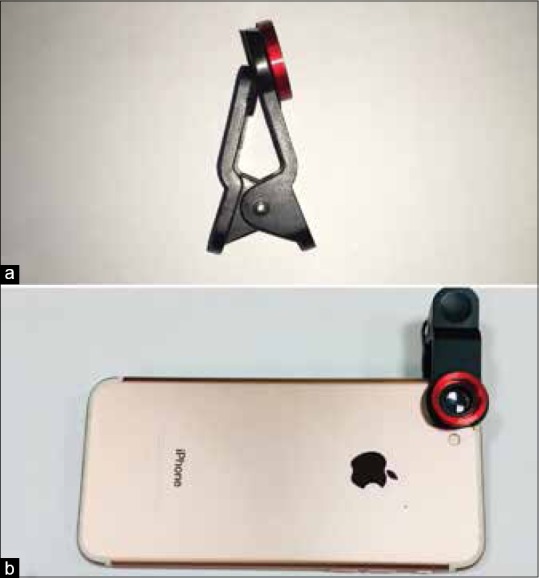Sir,
With the increasing use of smartphones in various aspects of our daily lives, application of the same in ophthalmology is not only logical but may also prove to be cost-effective if used appropriately. Photographic documentation of various ophthalmic pathologies is helpful both in the assessment of disease progression or regression and in explaining the same to patients or their family. Here in this report, we describe a simple way to acquire high-quality anterior segment images using a small portable magnifying lens. This would help in capturing anterior segment structures such as cornea, iris, and the lens with ease and reasonable clarity, thereby aiding in the better assessment of the pathology. The technique and the image quality specifications have been elaborated using a few examples.
Anterior segment photographic documentation is almost indispensable for an anterior segment surgeon. This usually involves high-cost machines which are fixed at a point in the clinic or examination room, which often hinders the examination of patients, especially those with low vision, and old age. A portable and high definition camera facilitated device would not only help in such cases, but also in saving precious clinical time in the current competitive scenario.
A smartphone is clipped with a commercially available magnifying lens [Fig. 1a and b]. The patient is made to sit either on a chair or the slit lamp. The clipped phone is moved towards the patient's eye to achieve the focus at the desired plane, and either a still photograph or a video can be obtained. Following are some of the examples of images acquired by this technique: (1) dilated anterior segment photography in a young patient having clear cornea and the lens [Fig. 2a], (2) posttraumatic corneal epithelial defect staining using fluorescence dye [Fig. 2b], (3) pseudophakic patient with iris claw lens [Fig. 2c], (4) developmental cataract [Fig. 2d], (5) microspherophakia with anteriorly dislocated crystalline lens [Fig. 2e], and (6) morgagnian cataract [Fig. 2f].
Figure 1.

(a) Small portable high magnification lens. (b) The lens mounted on the smartphone
Figure 2.

(a) Anterior segment imaging in a young patient having clear cornea and the lens. (b) Posttraumatic multiple corneal epithelial defects staining with fluorescence dye under cobalt blue filter. (c) Iris claw lens captured in a pseudophakic patient. (d) Developmental cataract. (e) Microspherophakia with an anteriorly dislocated crystalline lens. (f) Morgagnian cataract
Clinicians all over the world have witnessed a steep rise in the use of smartphones in various academic, research, and clinical aspects. With a few simple and cost-effective modifications, smartphones can be put to good use in ophthalmology. In the literature, although smartphone-based image capturing has been described previously the attachments used are large and bulky.[1] Here in this report, we highlight the usage of small portable and optimally attachable lens for high definition clear image acquisition of the anterior segment.
Financial support and sponsorship
Nil.
Conflicts of interest
There are no conflicts of interest.
Reference
- 1.Ahuja AA, Kohli P, Lomte S. Novel technique of smartphone-based high magnification imaging of the eyelid lesions. Indian J Ophthalmol. 2017;65:1015–6. doi: 10.4103/ijo.IJO_36_17. [DOI] [PMC free article] [PubMed] [Google Scholar]


